Konye-Urgench
Konye-Urgench
Konya-Urgench (or Konye Urgench or Kunya Urgench) is the ancient capital of the prosperous Khorezm empire as well as part of the Achaemenid Empire and was one of Central Asia’s greatest cities till a series of disasters. Kunya-Urgench is located in North-western Turkmenistan, at the west bank of the Amu Darya River and not far from Nukus in Uzbekistan. Here in Konya Urgench, lie the survived elements of ancient mausoleums and minarets that prove of the power and fame Urgench once possessed. The survived monuments in the area were mainly built between 11th and 16th centuries and include a mosque, the gates of a caravanserai, fortresses, mausoleums and a 60 m high minaret.
The monuments of Konye Urgench testify to outstanding achievements in architecture and craftsmanship that influenced reached Iran and Afghanistan and later the architecture of the Mogul Empire of 16th century India. Centuries ago, this place was also the center of the Islamic world. It absolutely has not had the easiest of histories, defeated both by the Mongols and by Timur, but enough monuments of strong architectural and historical interest have survived to make Konye-Urgench one of Turkmenistan’s most prominent tourist sights. In 2005 UNESCO named it a World Heritage Site.
Konye-Urgench actually means “Old Urgench” in the Persian language. Next to the ancient Urgench, there is a small more modern town holding a population of 15 000 people. It is a rural backwater with deserted squares, roaming sheep and roads that end in agricultural fields. The modern town does not have much to provide for tourists and most travelers overnight in Dashoguz. There is yet another Urgench next to Khiva on the Uzbek side, not to be confused with Konye Urgench. Tourists often combine visiting Khiva together with Konye Urgench (at times when the border is open).
Table of Contents
History of Konye Urgench
The first mentions on Konya-Urgench belong to the beginning of the 1st century AD, when Chinese sources cited the city of Yue-gan, which has been associated with the city of Gurgench or Urgench. In the later periods, this city was written about in connection with the most important political events in the region. Kunya-Urgench has been destroyed and rebuilt several times and miraculously restored often by the trade. By 1366 Konye Urgench had become the largest, greatest, most impressive and most significant city of the Turks. Ibn Battuta described a city so busy that a man could not move in the throng. Arab and Persian historians, geographers and travelers wrote an enormous amount of information of Kunya-Urgench.
In the 17th century, the Uzbek Khan Abulghazi shifted the water-starved population to a new location in the east of the oasis, closer to Khiva. Thus was born the new town of Urgench, in present-day Uzbekistan. The old capital became known as Konye-Urgench “Old Urgench”. In the middle of the 19th century Konye-Urgench obtained some attention again, thanks to the development of the Khan Yap irrigation canal by the Khans of Khiva and gradually settled into the agricultural center it is today. Now, most of Old Urgench lies forgotten underground, but there is enough to get an idea of its former fame.
Konye-Urgench Sights
The main sights of Konye-Urgench are spread out but they can still reached conveniently by foot. Just make sure to get enough sun protection, water and don’t forget to cover your head since sun here could be really strong during the summer months. There is no public transport as such, but you can always step on the curb and hail a taxi on the main roads or by the market.
The significant sights are grouped into two main groups. There is a small collection of monuments in the center of town, including the Mausoleum of Nedjmeddin Kubra from 12 – 13th centuries. It’s good to visit these first, as the museum presents useful general background information on the Kunye Urgench site. The remains of the ancient city are about a kilometer south of town, on both sides of the road to Ashgabat. Nearest to the town, you will find a complex of mausoleums belonging to 14th century, one of them being Turabeg Khanum Mausoleum. It is not far from the 11th century Gutluk-Temir Minaret, which, at 60 meters, was the highest brick minaret in the world before the construction of the Minaret of Jam in Afghanistan.
Gate of Caravanserai
The exact purpose of this historical structure remains a puzzle, with experts speculating about its original use. Was it an entrance to a caravanserai, serving as a resting place for travelers and merchants? Or perhaps it was part of a grander edifice, such as a palace or a madrasa? The ambiguity surrounding the gate only adds to its allure, mirroring the enigmatic nature of the region itself.
A fragment of the Gate of the caravanserai (peshtak) is covered by decor from fancy carved little bricks of natural beige color with dark blue, white and turquoise patterns. The majority of researchers agree that this peshtak is too fancy for a caravanserai and most likely belonged to the palace of Khorezmshakhs or a major madrasah. The only known fact is that it was intentionally destroyed by Tamerlane and the caravanserai was most likely built around the survived portal only later.
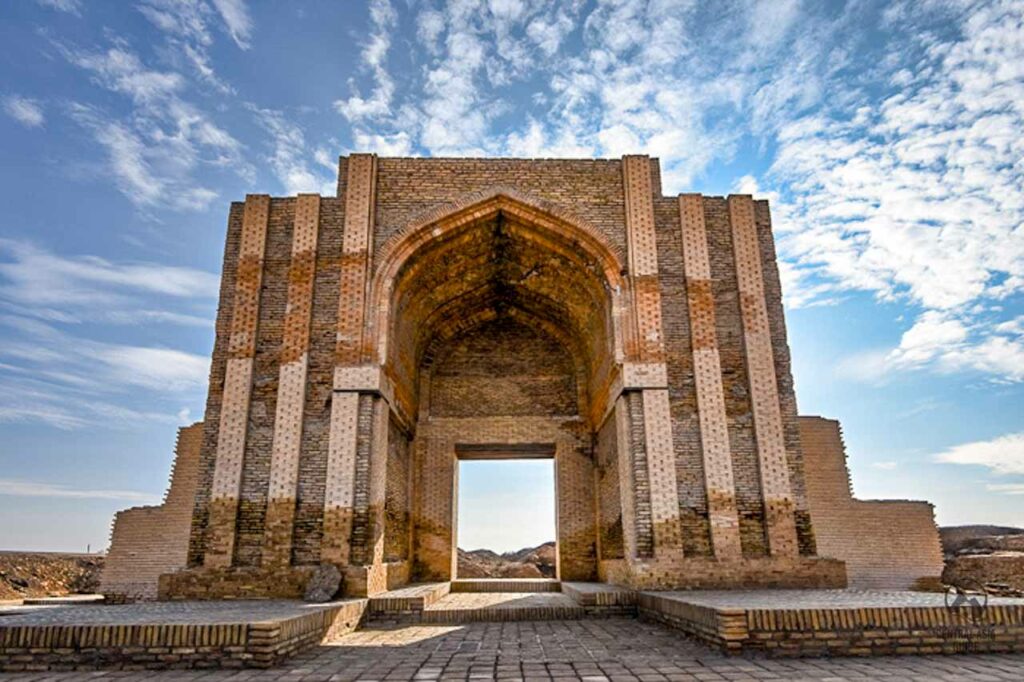
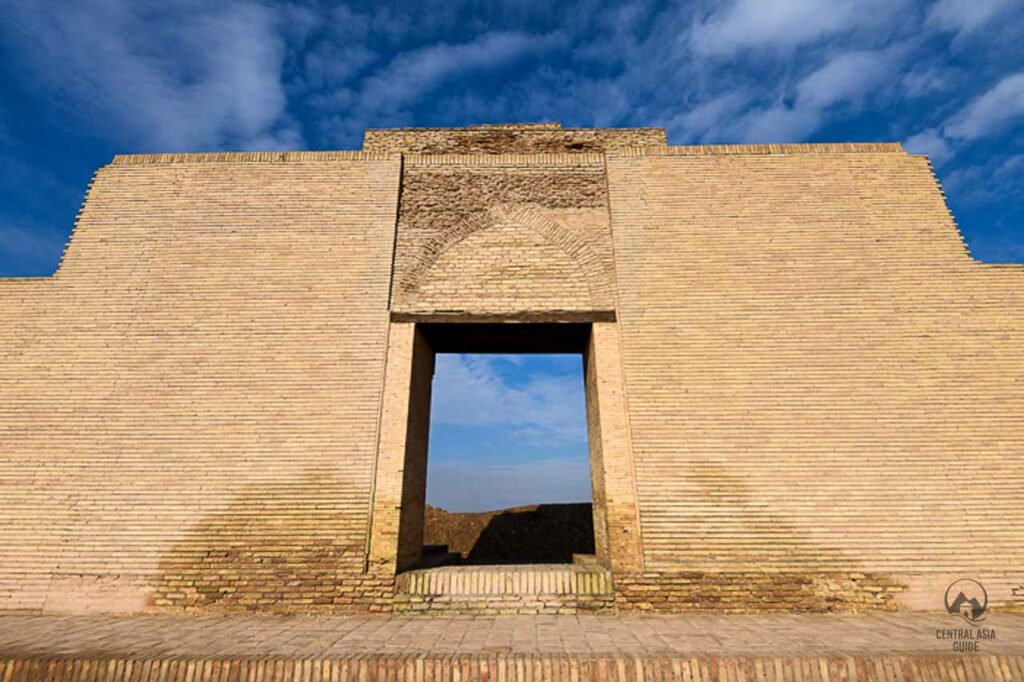
Konye-Urgench Museum
Konya-Urgench Museum is housed in a brick-built Dash Mosque, a former madrasa erected in the early years of the 20th century, located just before the main mausoleum complex. It consists of some ancient Arabic texts and a few interestingly labeled artifacts from Old Urgench. There are also Christian symbols carved on some of the stone pieces. Outside the madrassa, the courtyard has several rooms holding ethnographic displays of Turkmen culture, including a pottery workshop and carpet looms.
Konye-Urgench Mausoleums
Matkerim Ishan Mausoleum
Matkerim Ishan Mausoleum stands just immediately west of the Dash Mosque museum. This mosque houses the graves of 19th century religious teacher, Matkerim Ishan and his son Madamin Ishan.
The Matkerim Ishan Mausoleum, constructed between 1886 and 1889, is a modest late-19th-century building located on the northern side of Konye-Urgench, about 170 meters east-southeast of the celebrated Najm ad-Din al-Kubra Mausoleum from the early 14th century. It honors Matkerim Ishan, a local religious leader, and his son Madamin Ishan, who was buried there in 1912. Both taught at the adjacent Tash madrasa.
The mausoleum has been built from plain brick and without any ornamented elements of decoration. It represents the sharp decline in the economy experienced by Turkestan just after the Russian conquest had taken place. The architectural work is a domed chamber combined with an iwan, similar to other mausoleums in this area, including the famous Sultan Ali Mausoleum and the great Turabek Khanum Mausoleum. However, it does not have architectural finesse like its predecessors because of the simplicity the era enforced.

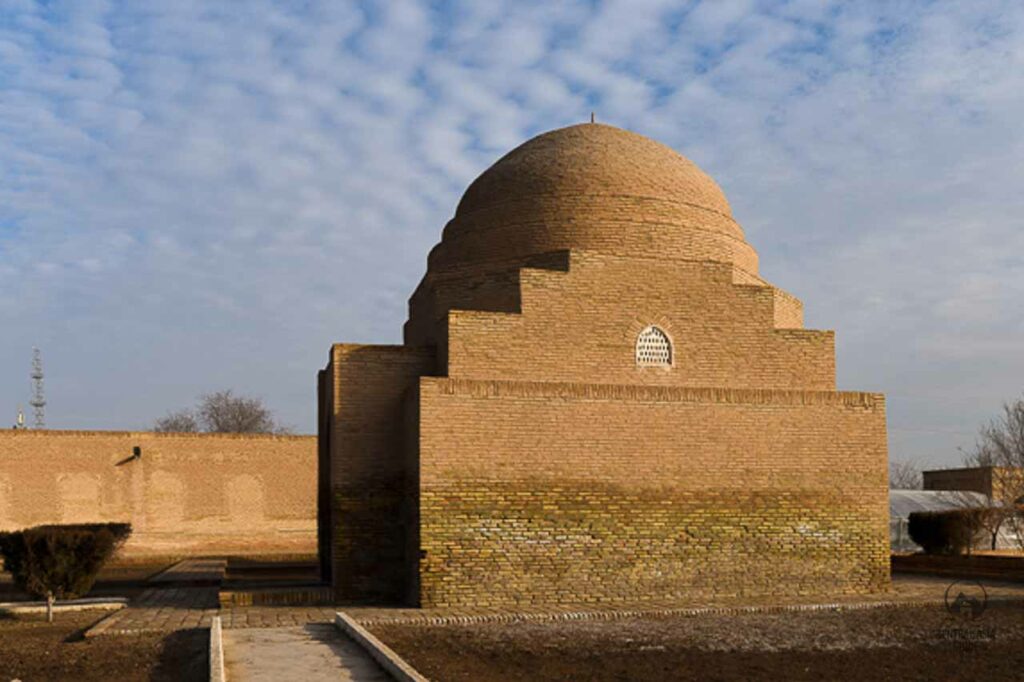
Heading further west you will be next to the attractive ensemble of buildings: Nejameddin Kubra Mausoleum and Sultan Ali Mausoleum facing across each other surrounding a shady little courtyard and Piryarvali Mausoleum.
Nedjmeddin Kubra and Sultan Ali Mausoleums
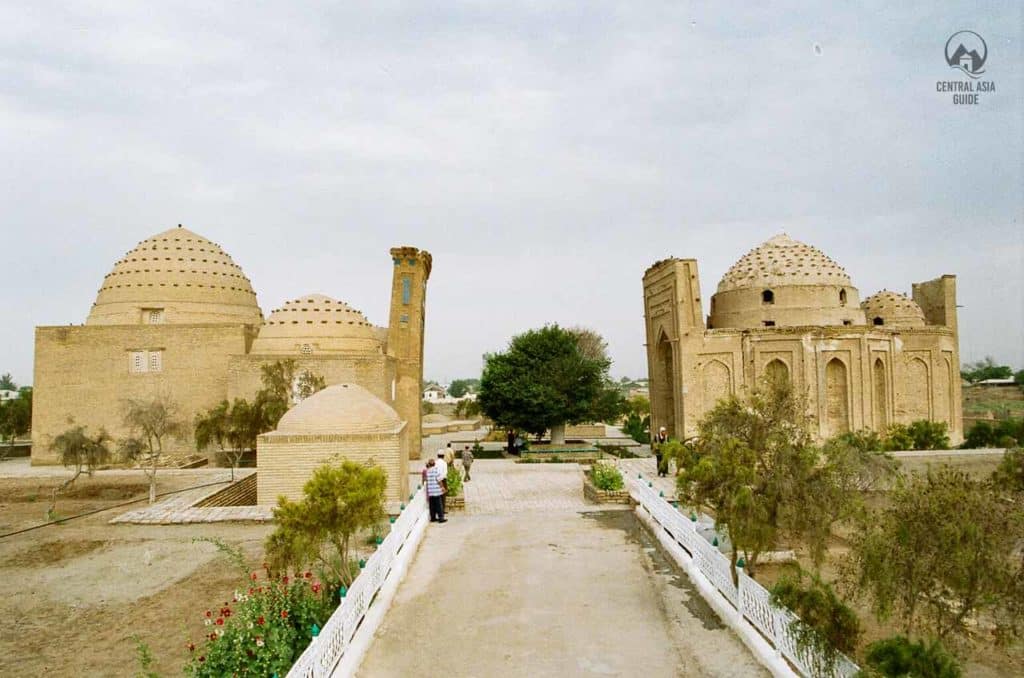
Nedjmeddin Kubra Mausoleum
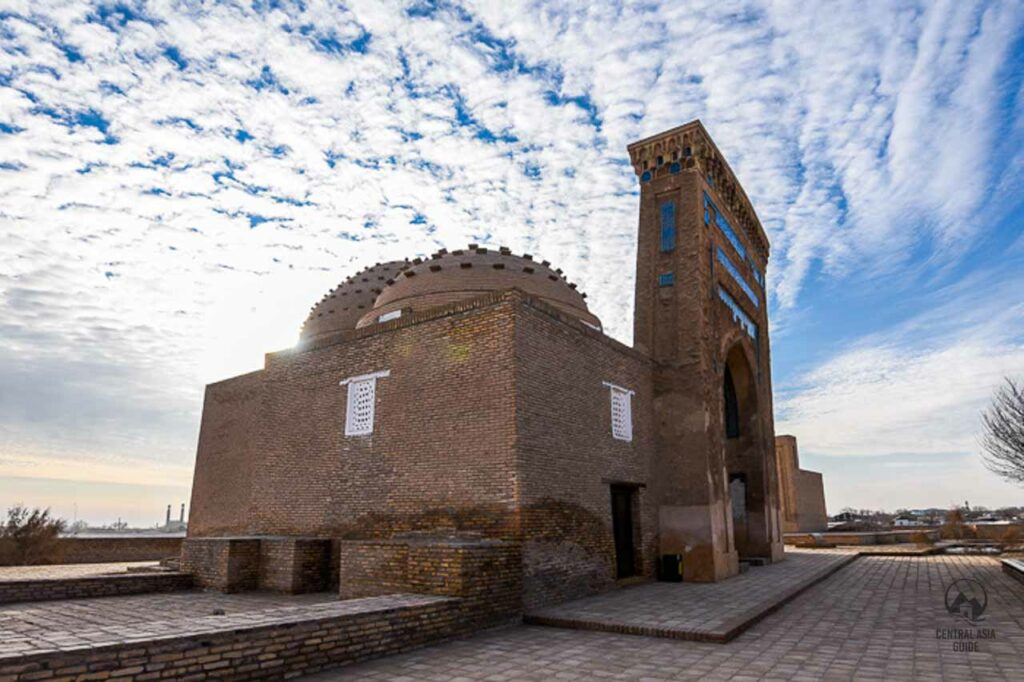
Nedjmeddin Kubra was the founder of the Kubravid school of Sufism, who was born in Khiva in 1145 and died here at the hands of the Mongols in 1221. The sacred Nejameddin Kubra Mausoleum is the most important sight of a small cluster of sights near the middle of the town and is the holiest part of Konye-Urgench.
The 14th-century mausoleum has a charming portal, with blue and turquoise tiles in geometric, floral and calligraphic designs. Nedjmeddin Kubra’s tomb itself is in two parts: the larger for his body, the smaller one for his head, which was separated by the Mongols. The tombs are covered with fine majolica tile-work, but this is covered over by velvet cloths.
Nedjmeddin Kubra mausoleum is a major place of pilgrimage: visitors circle it three times, touching the walls and then their foreheads while reciting prayers, before entering.
The Mausoleum of Soltan Ali stands in front of the Mausoleum of Nedjmeddin Kubra creating a symmetrical balance. The mausoleum’s domed building, with fractures in its exterior walls has altogether a rather parlous appearance. According to researches, it dates back to the 14th – 16th but it is not very certainly known. Soltan Ali himself, to whom the building may, or may not, have been dedicated, was a local governor who died in 1565.
The construction was never completed: the wooden beams protruding from the facade may have been required for ornamental tiling, which were not applied. One assumption states that the building was ordered by Soltan Ali’s successor, Haji Mohammed Khan, who was forced to leave Urgench in the 1580s by the advance of the forces of the Khan of Bukhara. The building is usually kept locked. The portals of the Mausolea of Nedjmeddin Kubra and Soltan Ali suggest two elderly gentlemen, politely bowing to each other.
Sultan Ali Mausoleum
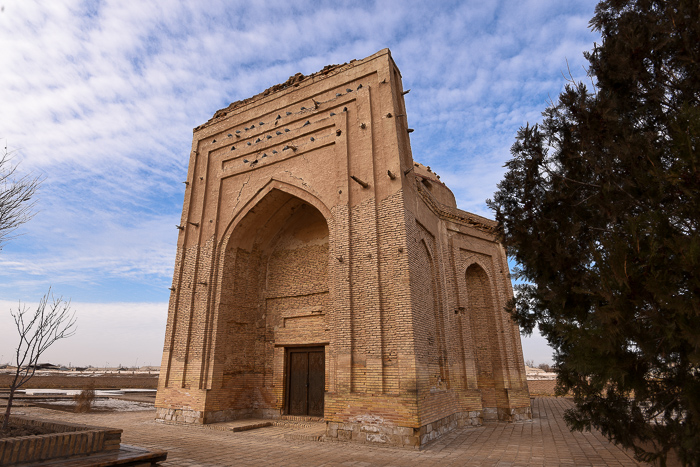
Piryarvali Mausoleum
Straight to the west of the Mausoleum of Nedjmeddin Kubra stands the massively renovated Mausoleum of Piryarvali. It is a brick-built domed structure with the large portal typical of the Konye-Urgench mausoleums. The building is usually kept locked but, if you are able to get inside, you will be faced with four adjacent cenotaphs, one of which is said to mark the grave of Piryarvali, a disciple of Nedjmeddin Kubra and the father of a well-known Khorezm poet and wrestler named Pakhlavan-Ata. The others are by local tradition ascribed to three Sheiks; Attar Vali, Duyar Vali and Daniyar Vali. A grave along the northern wall of the mausoleum is said to be that of Piryarvali’s brother, Pir Attar Vali, the patron of confectioners. A series of burial vaults were found close to the Piryarvali Mausoleum during its reconstruction in 1989.
There are various other graves nearby the main mausolea, many linked popularly to the names of disciples of Nedjmeddin Kubra or to local rulers. This graveyard, locally known as the “360′” is a reference to the membership of the Kubravid school of Sufism and is the basis of the more modern cemetery which surrounds the site. Several of the older graves are associated with rites of shrine pilgrimage. For instance, next to the two sharp graves just to the north of the path running to the Nedjmeddin Kubra Mausoleum stands a tree, bent by the wind in the direction of the tombs. The tree is said to have special powers in the treatment of children’s ailments and you may see parents splashing water into the faces of their children from the little pool at its base.
Turabek Khanum Mausoleum
Turabeg Khanym Complex is located opposite the ticket office. Residents and some scholars claim this is a mausoleum, though no-one is certain who is buried here. Turabeg Khanum was the daughter of Uzbek Khan, under whose rule the Golden Horde converted to Islam and the wife of Gutlug Timur, a governor of Urgench in the early 14th century. There is consideration among researchers as to whether the building had anything to do with her.
Some researchers believe that it was a mausoleum of the rulers of the Sufi dynasty, dating from the second half of the 14th century. Others point to the unusually well-illuminated interior, the presence of structures with a possible defense function (such as a small room opposite the staircase which has been described as a guard room) and the absence of cenotaphs to argue that the building may have been a palace, not a mausoleum.
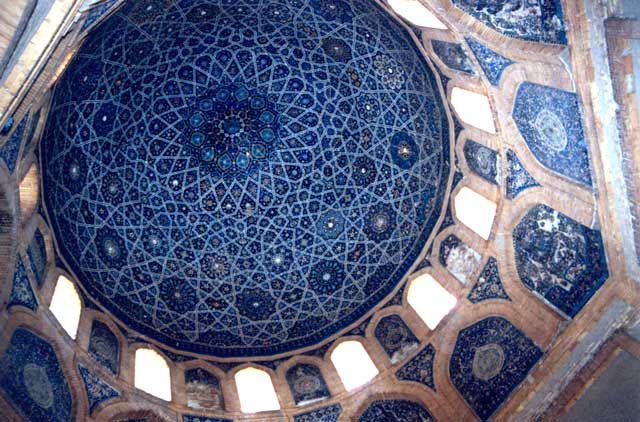
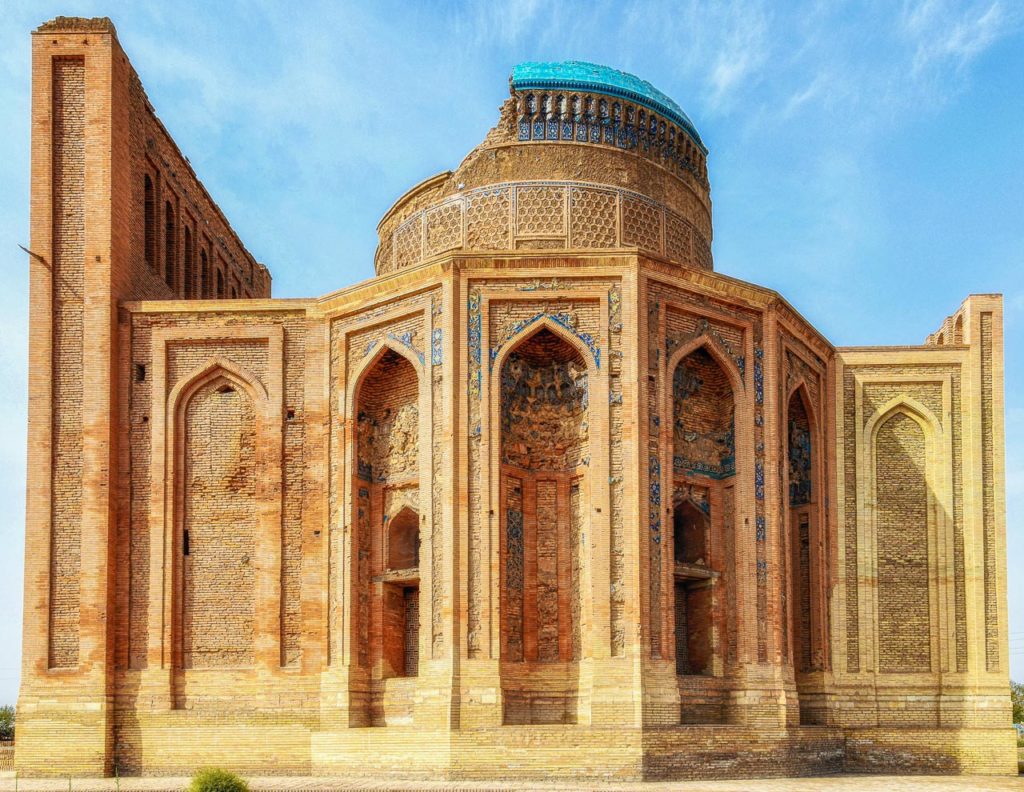
Seyit Ahmet Mausoleum
Mausoleum of Seyit Ahmet is the first building after Turabek Khanym mausoleum you will meet on the way east. A recent reconstruction of a 19th century mausoleum, is a twin-domed brick building, the cenotaph lying in the second and larger of the two chambers. It is linked by popular tradition to Sheikh Seyit Ahmet, who died around 1308 and played a major role in the Islamisation of the Mongol Khans of the Golden Horde.
Sultan Tekesh Mausoleum
The Mausoleum of Sultan Tekesh dates from the end of the 12th century or the beginning of the following one. Tekesh, who ruled from 1172-1200, turned the Khorezmshahs into a major power.
His conquests included locations as far as Khorasan in the present-day northern Iran. It is believed that he built this mausoleum for himself, along with a big madrassa and library (which have not survived) on the same spot.
Tekesh’s Mausoleum, a prominent structure in Konye-Urgench, showcases architectural grandeur with its square plan, conical roof, and a ribbed drum—an unusual feature in Central Asia but more common in Northern Iran.
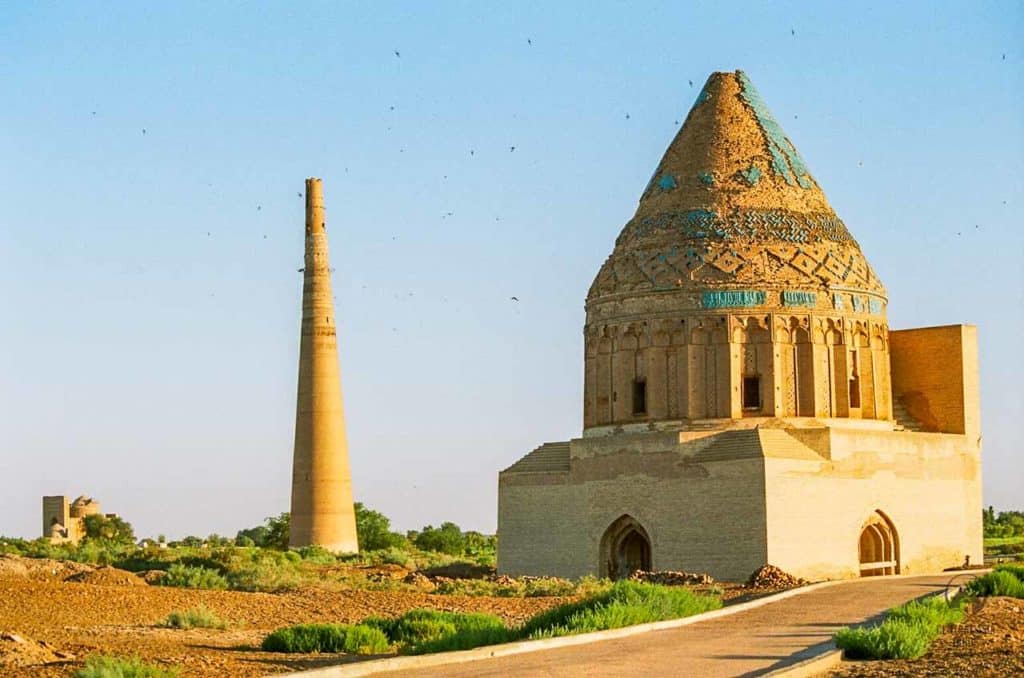
Measuring 18.5 meters on each side and with a dome rising 30 meters above the desert, it reflects stylistic advancements over its predecessor, Il-Arslan’s tomb. The exterior once featured a striking frieze of blue-glazed tiles with raised calligraphy, a first in Central Asia, although only a few fragments remain today. The ribbed drum and turquoise-tiled dome highlight the architectural innovations inspired by Tekesh’s campaigns in Northern Iran.
The mausoleum’s north-facing facade includes a towering brick portal adorned with muqarnas vaulting, lending an imposing appearance. Scholars debate its function—whether it served as Tekesh’s tomb or an audience chamber for the ruling family, possibly as part of a larger complex now lost. However, some scholars theorize that the building had existed earlier already as a Zoroastrian temple. Restoration efforts were underway as of 2019, ensuring the preservation of this culturally significant monument.
Il Arslan Mausoleum
Back on the main path, and following it south from the Tekesh Mausoleum, you arrive at the Mausoleum of Il Arslan, the popular Konye-Urgench monument of many visitors. Dated to the middle of the 12th century, the mausoleum is square in plan, with a beautifully decorated eastern facade, offering Arabic inscriptions and floral designs in terracotta.
Like that of the Tekesh Mausoleum, the cupola is conical in form, but unusually that of the Il Arslan Mausoleum retains the 12-sided structure of the drum below. The cupola is decorated with turquoise tiles, set in a playful zig-zag design.
The mausoleum is identified locally as that of Fahr ad-Din Razi, a well-known scientist of the 12th century, but he is known to have died in Herat around 1209. The building might nonetheless have been built in honor of Fahr ad-Din Razi, but some historians, looking for a suitably important person who died in Gurganj at the right time, have suggested that the tomb may be that of the Khorezmshah Il Arslan, father of Tekesh, who ruled 1156-1172. The scholar Az Zamakhshari has also been suggested as a possible occupant.

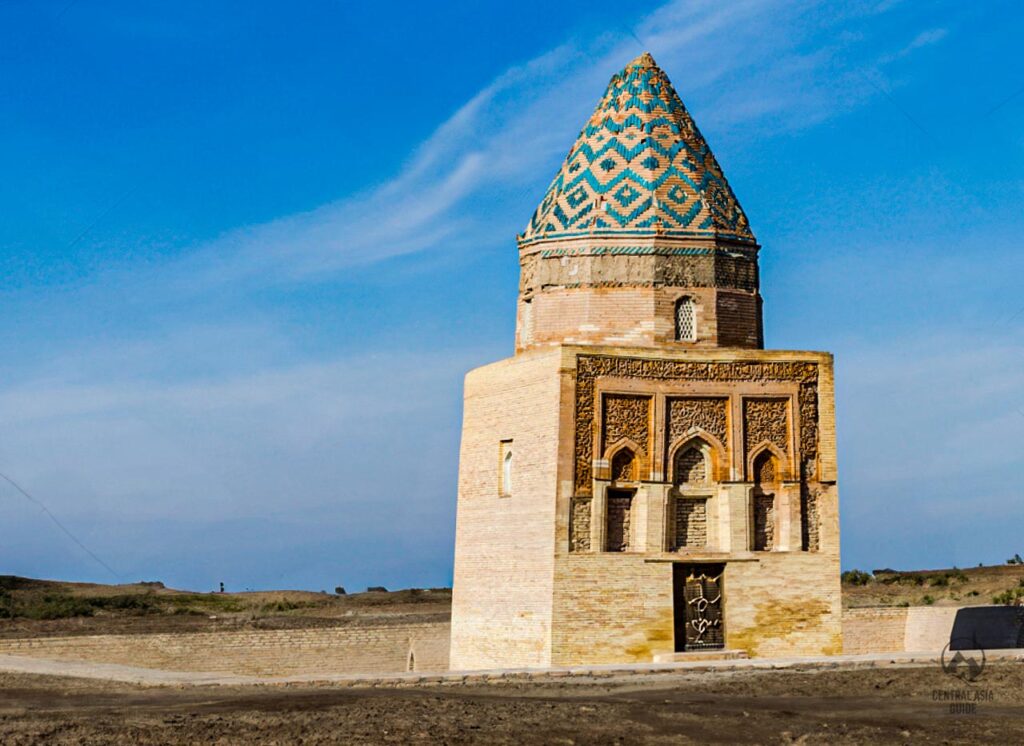
Konye Urgench Minarets
Timur Qutlugh Minaret
Qutlung (also written as Kutlung) Timur Minaret is still almost 60 m and is the tallest medieval construction in Central Asia. It was even taller before recent restoration work, aimed at stabilizing the still moderately unsafe-looking structure, which resulted in reducing the height by a couple of meters.
The minaret is an attractive, narrowing column, some 12 m in diameter at the base, but just 2 m wide at the top, on which a long-vanished wooden balcony would once have stood. There are 18 horizontal bands of decoration, some incorporating blue majolica tiles.
There are three bands of inscriptions in Kufic script, one of which links the minaret with Gutlug Timur and his father-in-law Uzbek Khan. This led researchers to date the monument to 1320-1330. But it is now actually believed that the minaret is much older, probably dating to the 11th or 12th century and that Gutlug Timur’s role was limited to ordering its reconstruction.
Note that there is no entrance to the minaret as it was earlier linked to the adjacent mosque by a bridge 7 meters above the ground. Since that mosque was destroyed, the only way into the minaret is by ladder. There are 144 steps to the top, but you can’t climb it now, most likely due to security reasons.
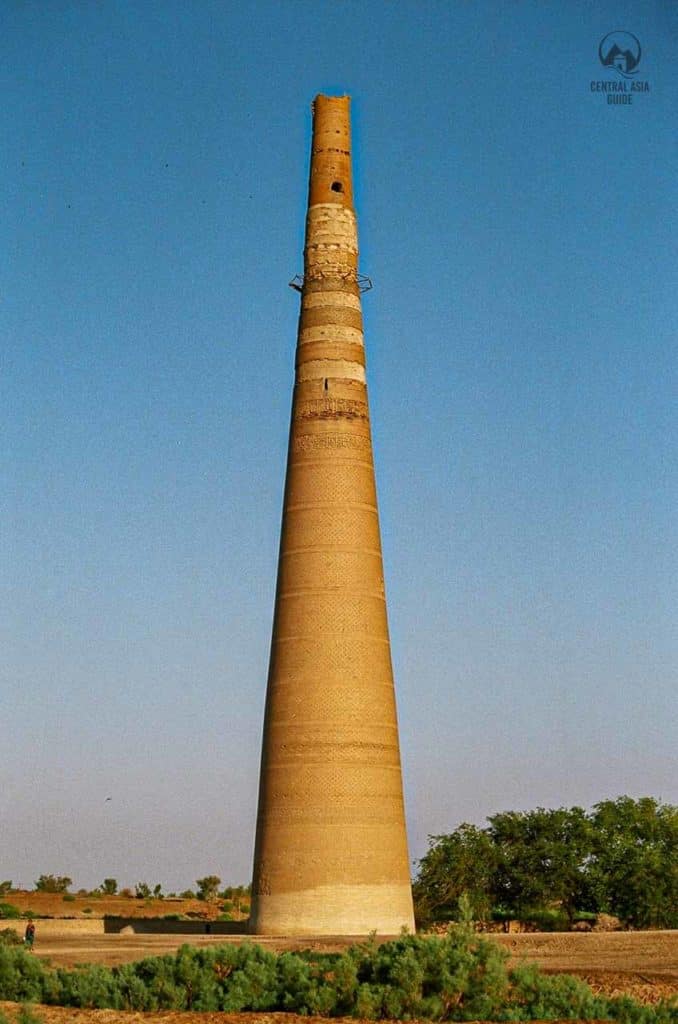
Mamun II Minaret
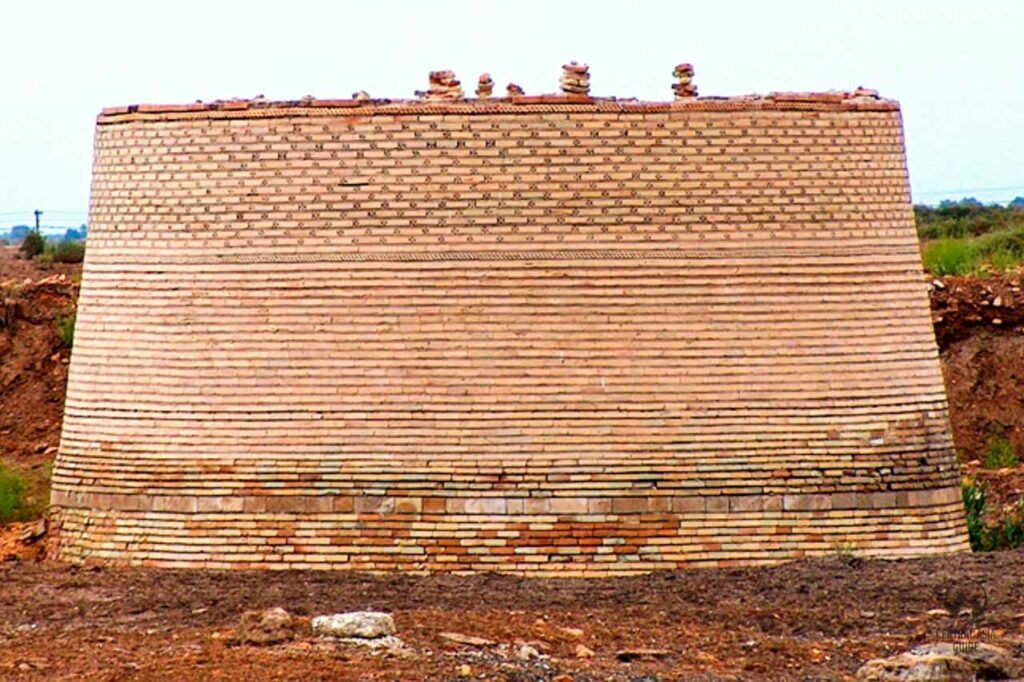
Mamun II Minaret was built in 1011, reduced to a stump by the Mongols, rebuilt in the 14th century and finally toppled down by an earthquake in 1895.
The base of the Mamun II Minaret lies anchored in the ground like a tree stump that the Mongols failed to uproot. Shards of tilework and an inscription observed in 1952 date the pre-Mongol minaret and Friday mosque to the year 1011. The minaret was paid for by Khoreznrshah Mamun himself “in humility toward religion, and to approach God, may his mention be great, and with the desire for recompense in this world and the hereafter.” (as inscribed on the minaret), it is even assumed that al-Beruni, court vizier at the time, may have influenced the construction with the idea of using it as an astronomical observation tower.
Konye Urgench Sweet Well
A well called the “Sweet well” is located just next to the Kutlung Timur Minaret. It is believed that you can be happy if you draw water from the well and drink it. Even if it would be true, be aware that drinking water may not be safe as your stomach might not be happy with the quality of the water in the well.
Konye Urgench Foretresses
Kyrk Molla Hill
Walking south from the Tekesh Mausoleum one will stumble on a low hill, covering some 3 ha and never much more than 12 m in height. The hill carries the interesting name of Kyrk Molla (’40 Mullahs’). Diggings along it’s western slope have revealed the inclined walls of a fortress punctuated by square towers. This is believed to be the ancient heart of Gurganj: some finds here have been dated to as early as 5th-century BC. Researchers believe that the fortress was destroyed on the arrival of the Arabs in the 8th century.
Local legends surrounding the name of the place are based around the 40 mullahs as wise teachers, leading to suggestions that this may have thereafter been the site of an important madrasa or even the fabled Academy of Ma’mun. One tale tells that, with the dreaded Mongols fast approaching, the 40 mullahs prayed that the rare and beautiful books of the Academy would be spared. Their prayers were answered by the Academy suddenly turning upside down, so that its doors were underground, out of reach of the Mongols. And this is how the tale concludes, the hill was formed. The great books remain below ground, still waiting to be uncovered. Later the area has been used as a cemetary.
Kyrk Molla is one of the most atmospheric places in Konye-Urgench and also an important pilgrimage destination with the branches of wizened trees covered in strips of cloth marking the prayers and wishes of visitors and crows caving around. Human skulls might also stare out from the excavated western slope of the hill. Across the top of the hill, there are hundreds of little stone huts, and miniature cradles fashioned from pieces of cloth, the legacy of the fertility wishes made here. On the eastern side of the hill, you may see groups of girls rolling each other down the slope, an activity said to promote fertility, though it appears more likely to have the opposite effect.

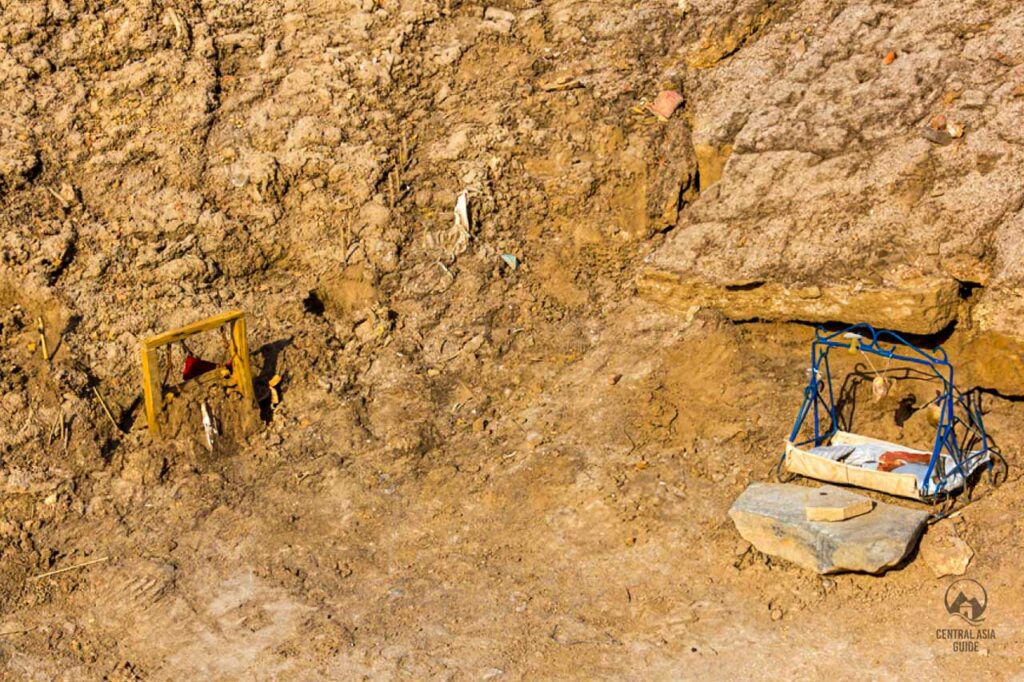
Dash-Kala
The ancient settlement of Dashkala existed in the Mongolian, Timurid and post Timurid periods. The remains of moated walls here include Dash Gala, the pre-Mongol settlement which may later have formed the citadel of the larger city of Urgench. Inside Dash Gala, not far from the site of its north gate, is the stump of the Ma’mun Minaret but it is fairly hard to see the borders of the ancient city now.
Ak-Kala Fortress
To the east of the Caravansaray Gate, just outside the confines of Dash Gala, is the fortress known as Ak Gala. Its southern wall ran alongside the old channel of the Amu Darya, making a formidable defensive barrier. The fragments of mud-brick walls which survive along its 1 km perimeter reach a height up to 8 m. These probably date to no earlier than the 16th century but are built on top of earlier walls, destroyed by Timur. Researchers have speculated that this fortress may have been the Keshk-i-Ahchak mentioned by a 13th-century scholar as one of two monuments of Urgench (the other being the Tekesh Mausoleum) not destroyed by the Mongols.
Khorezm Bagh Fortress
Khorezm Bagh is a large rectangular shaped fortress that lies in the southwest corner of the archaeological site, west of the Ashgabat road. It is a modern monument, though built on the site of a citadel which probably dates to the time of the Golden Horde. It was constructed on the order of a Khan of Khiva named Mohammed Emin, who decided in 1846 that he would make Konye-Urgench his place of residence. This plan was terminated abruptly by Mohammed Emin’s death in battle in 1855, meaning it was also the end for Khorezm Bagh fortress.
How to get to Konye-Urgench
Train
The railway station is south of town, just behind the main archaeological park on the Ashgabat road. Konye Urgench railway sattions offers just one slow train daily to Dashoguz (4,5 h) and the agricultural town of Saparmurat Turkmenbashy. If one wants to enjoy the slow travel by train, it is not a bad option to travel to/from Dashoguz by train.
Bus / Taxi
The town’s bus station is located opposite the Gurgench Hotel where taxis, marshrutkas and buses meet and pick up passengers. You can also take a taxi ride from the town center. Frequent buses and marshrutkas go to Ashgabat, taking about eight hours and Dashogus can be reached in about two hours. The border to Uzbekistan is just 20 km away and a taxi to go there can be picked up all around in Konye Urgench.
Sights & Destinations near Konya-Urgench
Page updated 12.12.2024